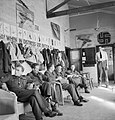Lloyd Loom
Lloyd Loom ( English ; literal translation and original meaning: Lloyd loom ) is the name for a machine- woven textile made of twisted Kraft paper ( paper yarn ). A special feature of the material is that the paper yarn is twisted around a metal wire that acts as a core and thus has a higher tensile strength . The name is best known today for the furniture made from this material in several countries , especially the so-called Lloyd Loom Chairs .
History, properties and uses
Between 1906 and 1917, the American inventor and entrepreneur Marshall Burns Lloyd (1858–1927) in Menominee (Michigan) developed a process for the machine production of a fabric from Kraft paper. Here, the kraft paper is in a first step around a metal wire around a yarn spun ( twisted ) and then to weaving to basket-like mats ( woven reed processed). The new kind of "wickerwork" created by this textile-technical mechanization , which, in contrast to goods from traditional basket weaving, is much faster and cheaper to manufacture, was initially used for articles such as the Lloyd Loom stroller , and soon also for the construction of seating furniture , as cover material (covering ), whereby it was stretched onto frame structures developed by Lloyd . The right to use the method ( Method of Producing Woven-Reed Articles ), which had been registered as a patent in the United States on July 17, 1917 , was offered for sale in Europe by Lloyd in 1919.
Since the 1920s, the material Lloyd Loom has inspired many furniture designers - especially in the United Kingdom - to create timeless designs, of which the so-called Lloyd Loom Chairs are still very popular today because of their durability and durability. In these chairs or armchairs , the material is often attached to frames made of slim, curved beech wood . In contrast to seating made of classic wickerwork, it does not creak or warp. Because of their low weight , the Loom Chairs were and are used in particular on passenger ships and airships, on grandstands, in hotels, restaurants and dining rooms and as seating in and on gardens ( terraces , winter gardens , verandas and loggias ). In addition to chairs and armchairs, sofas, loungers, beds, benches, stools, ottomans, laundry baskets, sideboards, bedside tables, side tables, sofa tables and cupboards are also made from the material. As a biodegradable material , Lloyd Loom is particularly valued these days.
Examples
literature
- Lloyd Manufacturing Company (Ed.): Lloyd Loom Products: Furniture, Catalog , Issue 106, Geo. F. McKiernan & Company, 1926
- Lee J. Curtis: Lloyd Loom. Woven Fiber Furniture . Salamander Books Limited, London 1997
- Lee J. Curtis: Lloyd Loom. Living with classic wicker furniture . Mosaik Verlag, Munich 1999
- Bruce W. Miller, Jim Widess: The Book of Woven Chair . (Original edition: The Caner's Handbook , New York / USA, 1983) Verlag Th. Schäfer, Hannover 2005, ISBN 3-87870-572-7 , p. 118 ( online )
Individual evidence
- ^ Louisa Knapp, Edward William Bok: Ladies' Home Journal , Volume 43, Issue 1, 1926, LHJ Publishing Incorporated, p. 121
- ↑ Marshall B. Lloyd patents (Google research)
- ↑ Method of producing woven-reed articles (Publication number: US 1298233 A)




